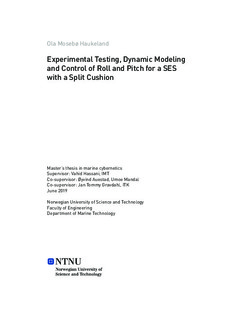| dc.contributor.advisor | Hassani, Vahid | |
| dc.contributor.advisor | Auestad, Øyvind | |
| dc.contributor.advisor | Gravdahl, Jan Tommy | |
| dc.contributor.author | Haukeland, Ola Mosebø | |
| dc.date.accessioned | 2019-10-23T14:01:53Z | |
| dc.date.available | 2019-10-23T14:01:53Z | |
| dc.date.issued | 2019 | |
| dc.identifier.uri | http://hdl.handle.net/11250/2624002 | |
| dc.description.abstract | Denne masteroppgaven undersøker egenskapene for rull og trim demping til et overflateffektskip med en luftpute som er delt inn i fire separate putekamre. Denne nye puteinndelingen gjør det mulig å generere et motvirkende rull og trim moment ved å manipulere trykket i hvert av putekamrene.
Umoe Mandal har utviklet en matematisk modell som kan brukes til å simulere pute dynamikken for et overflateeffektskip med én luftpute. I denne oppgaven blir modellen utvidet for å uttrykke pute dynamikken og å regne ut de tilhørende putekreftene for en SES med fire luftputer. I tillegg blir den eksisterende modellen endret for å ta hensyn til varierende putekammergeometri som en funksjon av hiv, rull og trim. Noen ekstra endringer i den matematiske modellen gjøres med hensyn til luftstrømmen inn og ut av putekammerene. Den matematiske modellen er implementert i MATLAB/Simulink og innlemmes i et større system som brukes til å simulere bølger og de hydrodynamiske kreftene som virker på fartøyets skrog. To enkle PID-kontrollere designes og anvendes for kontroll av hiv, rull og trim.
Mot slutten av prosjektet utføres flere modellskalaforsøk i NTNU sitt bølgebasseng. Resultatene fra disse testene brukes til å verifisere nøyaktigheten til den matematiske modellen. Dataene som samles fra disse testene bekrefter at den matematiske modellen fungerer som en god tilnærming av det fysiske systemet. Dataene fra disse forsøkene bekrefter også at rull- og trimdemping egenskapene til en SES med fire putekammer er betraktelige. For bølgebassengtestene med regulære bølger reduseres rullbevegelsen med opp til 76,7%. For irregulær JONSWAP sjø reduseres den signifikante rullevinkelen med så mye som 54,2%. For trimdemping er de tilsvarende tallene henholdsvis 66,8% og 49,8%. Resultater generert fra de numeriske simuleringene indikerer at under mer ideelle forhold kan så mye som 80-90% demping av rull og trim være oppnåelig.
Modeltestene utføres ganske nær avhandlingsfristen og videre arbeid burde derfor omfatte en dypere analyse av dataene fra modellskalatestene. Med hensyn på den matematiske modellen indikerer resultatene fra skalamodelltestene at videre arbeid burde omfatte en forbedring av modelleringen av luftstrømmen ut av putene, spesielt med tanke på luftlekkasje. Kontroll av luftstrømmen inn og ut av putekamrene er kritisk for å opprettholde god kontroll over bevegelsene til skipet. For en fysisk implementering i fullskala må veggene som inndeler luftputekammerene være mulige å trekke tilbake når skipet skal forflytte seg. Samtidig må veggene som inndeler luftputekammerene være utformet for å minimere luftlekkasjen fra kammer til kammer når kontroll av rull og trim er ønsket. Den nåværende løsningen gir svært lovende resultater, men videre arbeid og forbedring av denne inndelingen vil trolig kunne gi enda bedre resultater. | |
| dc.description.abstract | This master thesis investigates the roll and pitch damping properties of a surface effect ship with an air cushion that is divided into four separate cushion chambers. This new four cushion solution makes it possible to generate a counteracting roll and pitch moment by manipulating the pressure inside each of the cushion chambers.
Umoe Mandal has developed a mathematical model that is used to simulate the cushion dynamics of a single cushion surface effect ship. In this thesis, the model is expanded to express the cushion dynamics and cushion forces for a vessel with four cushions. In addition, the existing model is altered to account for varying cushion chamber geometry as a function of the heave, roll and pitch motion of the vessel. Some additional minor changes are also made to the mathematical model with respect to the cushion air flow. The mathematical model is implemented in MATLAB/Simulinkand is combined with a larger system used to simulate waves and the hydrodynamic forces acting on the vessel hull. Two simple PID controllers are designed and applied for control of heave, roll and pitch.
Towards the end of the project several model scale tests are performed in the NTNU wave basin. The results from these tests confirm that the mathematical model acts as a good approximation of the physical system. The data from these experiments also confirm the efficacy of the roll and pitch damping capabilities of the split cushion SES. For the wave basin tests simulating regular waves, the peak to peak roll angle is reduced by as much as 76.7%. For irregular JONSWAP sea, the significant roll angle is reduced by as much as 54.2% . For pitch damping, the same numbers are 66.8% and 49.8% damping respectively. The results generated from the numerical simulations indicate that under more ideal conditions, as much as 80-90% damping for both roll and pitch may be obtainable.
The model tests take place quite close to the thesis deadline, and further work should include further analysis of the data from the scale model tests. With respect to the mathematical model, the initial results from the scale model tests indicate that further work should include improving on the modeling of the cushion air flow, specifically the cushion air leakage. Controlling the airflow within the cushion chambers is key to maintain a good degree of motion control. For the physical implementation, the cushion separation walls need to be retractable during transit. In addition, the separation walls must be designed to minimize the air leakage from chamber to chamber during pitch and roll control. Though the current solution provides very promising results, further work and improvement on this design may produce even better results. | |
| dc.language | eng | |
| dc.publisher | NTNU | |
| dc.title | Experimental Testing, Dynamic Modeling and Control of Roll and Pitch for a SES with a Split Cushion | |
| dc.type | Master thesis | |
